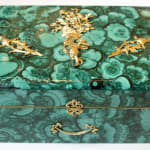Malachite Box with Gilt Silver Attachments, 1940 CE - 1960 BCE
Malachite
7 x 3 x 4.5
CK.0782
Further images
-
(View a larger image of thumbnail 1
)

-
(View a larger image of thumbnail 2
)

-
(View a larger image of thumbnail 3
)

-
(View a larger image of thumbnail 4
)

-
(View a larger image of thumbnail 5
)

-
(View a larger image of thumbnail 6
)

-
(View a larger image of thumbnail 7
)

-
(View a larger image of thumbnail 8
)

-
(View a larger image of thumbnail 9
)

Of vivid green hue often banded with black, malachite is a hydrous copper carbonate first mined by the ancients in the 4th millennium B.C. The famous mines of King Salomon...
Of vivid green hue often banded with black, malachite is a hydrous copper carbonate first mined by the ancients in the 4th millennium B.C. The famous mines of King Salomon in the Wadi Arabah were an important source of malachite, which was used for jewelry and talismans as well as a cosmetic for the eyes when powdered. The Egyptians prized it especially for this reason, and members of the nobility, bath men and women, applied it to their eyelids with ivory sticks. Not only did it make the wearer more attractive, but it was also believed to prevent infections and other diseases of the eye, for which purpose it is still used today. For centuries, malachite bas been employed especially as a talisman for children, thought to protect them from ail the diseases and difficulties of the very young. In Europe today, malachite is frequently hung around the necks of babies, or placed above the cradle where they sleep. It is also said to relieve toothache and pains of the mouth. Because of its high copper content, malachite when worn helps the body to overcome problems caused by deficiencies of this mineral, especially arthritis. In Imperial Russia, it was used extensively for jewelry and objets de vertu, especially by the house of Faberge.
The decorative arts of the late Russian Imperial era are epitomized by the world famous House of Fabergé. Their flagship establishment at 26 Bolshaya Morskaya in St. Petersburg attracted the rich and famous from the world over who came to shop at this exclusive boutique in search beautiful, jewel-encrusted articles which they would use in their everyday life. Of all their creations, none are as celebrated as their Imperial Easter Eggs; however, Fabergé created a diverse line of luxurious decorative offerings. A box such as this one, while not a work of Fabergé, very much reflects the influence of their taste and style. Only the finest materials are used: bright green malachite with intricately cast gilt silver fittings inlaid with rubies. This box evokes the beauty and sophistication of Imperial Russia. Although that world has long since vanished, through objects such as this box we can glimpse the luxury that defined the lives of the Czars and the aristocracy.
The decorative arts of the late Russian Imperial era are epitomized by the world famous House of Fabergé. Their flagship establishment at 26 Bolshaya Morskaya in St. Petersburg attracted the rich and famous from the world over who came to shop at this exclusive boutique in search beautiful, jewel-encrusted articles which they would use in their everyday life. Of all their creations, none are as celebrated as their Imperial Easter Eggs; however, Fabergé created a diverse line of luxurious decorative offerings. A box such as this one, while not a work of Fabergé, very much reflects the influence of their taste and style. Only the finest materials are used: bright green malachite with intricately cast gilt silver fittings inlaid with rubies. This box evokes the beauty and sophistication of Imperial Russia. Although that world has long since vanished, through objects such as this box we can glimpse the luxury that defined the lives of the Czars and the aristocracy.








